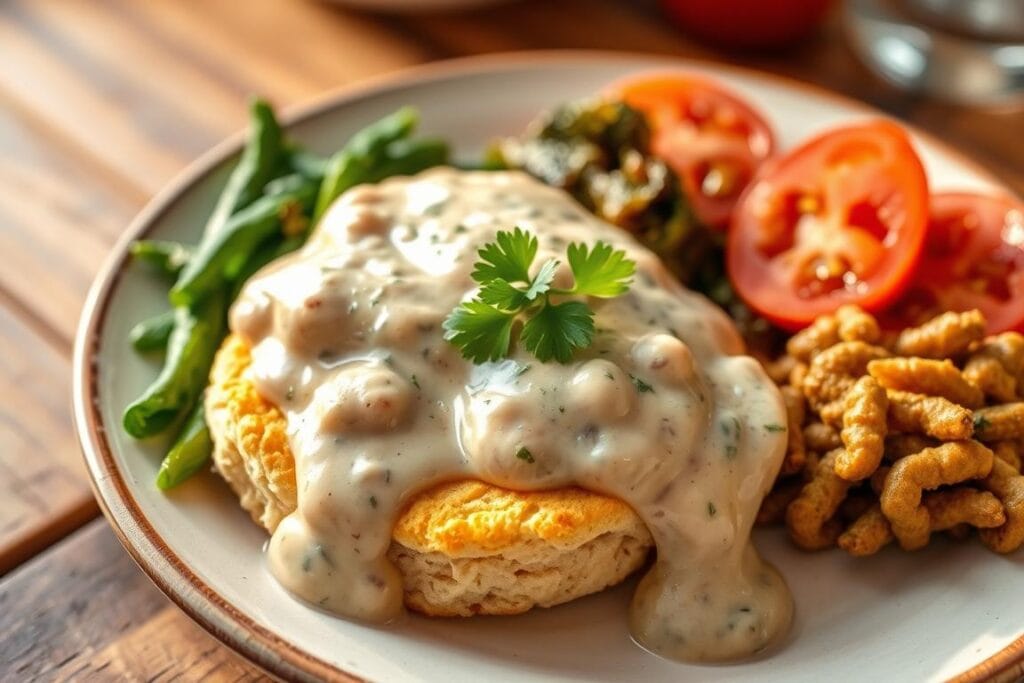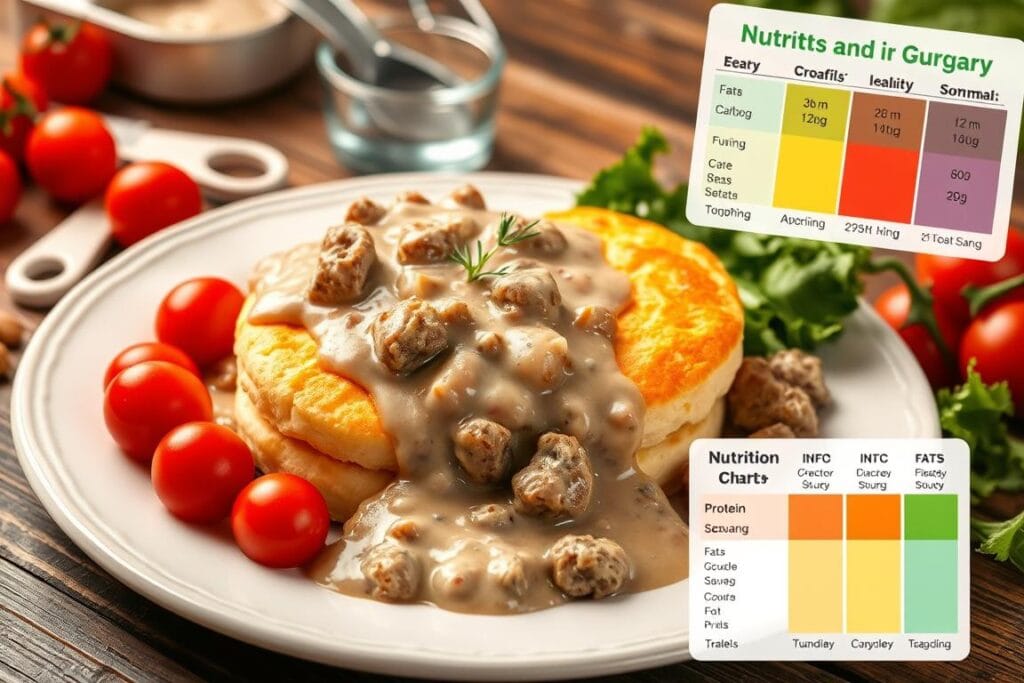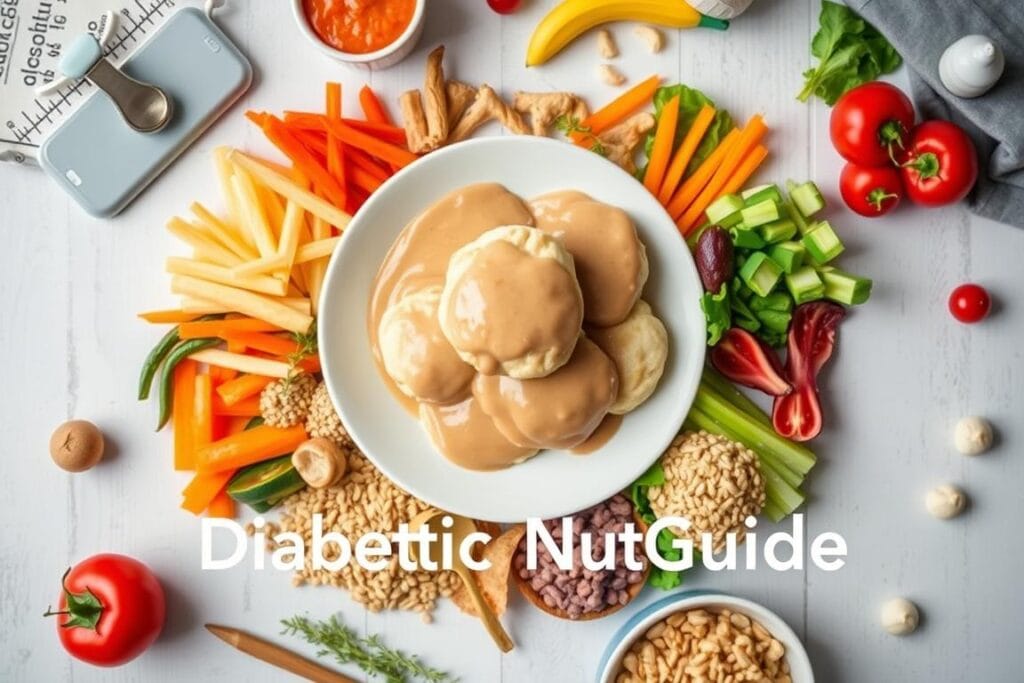
Chicken biscuits and gravy, a beloved Southern comfort food, may seem off-limits if you’re managing diabetes. However, with thoughtful ingredient swaps and portion control, you can enjoy chicken biscuits and gravy without compromising your health. This guide offers practical tips to make this dish both delicious and diabetes-friendly.
Key Takeaways
- Diabetes doesn’t prevent enjoying comfort foods with careful planning
- Ingredient modifications can make biscuits and gravy diabetes-friendly
- Portion control is key for managing blood sugar
- Low-glycemic alternatives exist for traditional ingredients
- Understanding nutritional content helps make informed meal choices
Understanding Blood Sugar Impact of Biscuits and Gravy
Exploring how biscuits and gravy affect blood sugar is key. We need to look at the dish’s glycemic index, carbs, and blood glucose impact. This helps us understand how it works with our metabolism.

Glycemic Index of Traditional Gravy
Traditional gravy has a low glycemic index. This means it doesn’t cause big blood sugar spikes. The protein and fat in it slow down how fast glucose is absorbed. But, the ingredients used are very important.
Gravy made with refined flour or sugars can change its glycemic index a lot.
Carbohydrate Content in Biscuits
Biscuits are the main carb source in this dish. They have about 30-40g of carbs. The white flour in biscuits has a high glycemic index. This can make blood sugar rise quickly.
- Refined flour biscuits spike blood sugar quickly
- Whole grain alternatives offer slower glucose release
- Portion control is key for blood sugar management
Blood Sugar Response to Combined Meal
Biscuits and gravy together have a complex effect on blood sugar. The gravy’s proteins and fats help slow down glucose absorption. But, the high-carb biscuits are a challenge for blood sugar control.
People with diabetes need to plan their meals carefully. They should focus on portion sizes and how to balance their meals.
Understanding your body’s unique response to different foods is key for managing blood glucose.
Key Nutritional Considerations for Diabetics
Managing diabetes means you need to plan your meals carefully. Counting carbs is key to keeping your blood sugar stable. It’s important to know how different foods affect your blood sugar.

Diabetics need to watch what they eat closely. Fiber is important because it doesn’t raise blood sugar and helps slow down glucose absorption. Net carbs are what you get after subtracting fiber from total carbs. This gives you a clearer idea of your carb intake.
“Nutrition is the cornerstone of diabetes management” – American Diabetes Association
- Prioritize protein in every meal to stabilize blood sugar
- Include healthy fats to improve nutrient absorption
- Choose complex carbohydrates over simple sugars
- Monitor portion sizes carefully
It’s vital to understand what’s in your food. Look at the total carbs, protein, and fat, not just sugar. This helps with meal planning for diabetics.
| Nutrient | Recommended Focus | Diabetic Considerations |
|---|---|---|
| Carbohydrates | 45-60g per meal | Choose low glycemic index options |
| Protein | 15-20g per meal | Helps stabilize blood sugar |
| Healthy Fats | 20-35% of daily calories | Supports nutrient absorption |
Your diet needs may be different. Talking to a registered dietitian can help make a meal plan that fits your health goals.
Traditional Ingredients and Their Effects on Blood Sugar
It’s key for diabetics to know what’s in their gravy. Instant gravy mixes have many parts that can affect your blood sugar. These parts can change how much sugar you take in and how your body reacts to it.
Traditional biscuits made with refined white flour are high in carbohydrates, which can cause blood sugar spikes. Opting for alternatives like whole grain flour-based biscuits or almond flour biscuits helps slow glucose absorption.
Impact of Flour-Based Thickeners
Thickeners like flour add carbs to gravies. Instant mixes have 5-6 grams of carbs per serving. This can make your blood sugar go up fast. Diabetics need to watch out for these thickeners:
- Wheat flour
- Cornstarch
- Modified food starch
Role of Fats and Proteins
Fats and proteins are important too. They help control how fast your body absorbs sugar. Lean meats like skinless chicken or turkey can make a gravy that doesn’t raise your blood sugar too much.
Hidden Sugars and Starches
Some ingredients, like sodium and flavor enhancers, can hide carbs. Things like maltodextrin or yeast extract might add sugars you don’t expect. Try these instead:
- Xanthan gum
- Almond flour
- Coconut flour
“Knowing what’s in your food is the best way to keep your meals safe for diabetes.”
By knowing what’s in your gravy, you can choose healthier options. This way, you can enjoy tasty gravies without harming your health.
Healthier Alternatives for Gravy Thickeners
Managing diabetes means finding the right gravy thickeners. Traditional wheat flour and cornstarch can raise blood sugar. But, there are healthier options that taste great and are good for you.
Here are some diabetic-friendly thickening options:
- Almond flour: A low-carb powerhouse that adds nutty richness
- Coconut flour: Provides subtle sweetness with minimal carbohydrates
- Xanthan gum: Delivers smooth texture without glycemic impact
- Pureed vegetables: Creates creamy consistency naturally
*Pro Tip*: When using almond flour or coconut flour, start with small amounts. Use about 1-2 tablespoons of almond flour or 1 teaspoon of coconut flour per cup of liquid. For xanthan gum, a quarter teaspoon per cup works perfectly.
“Healthy cooking isn’t about restriction, but smart ingredient substitution.” – Diabetes Nutrition Expert
Pureed vegetables are great for thickening. Cauliflower makes a silky texture. Roasted bell peppers or carrots add depth and nutrition. Sautéed mushrooms bring an umami flavor that makes your gravy delicious without harming your health.
Remember, moderation and choosing the right ingredients are key. This way, you can enjoy tasty, diabetes-friendly meals.
Making Diabetic-Friendly Chicken Biscuits and Gravy
Creating meals for diabetics means choosing the right ingredients and cooking methods. You can turn chicken biscuits and gravy into a healthy dish. This helps manage blood sugar levels.
- For Biscuits: Replace refined flour with almond or coconut flour. Explore recipes like this chicken biscuits and gravy alternative for inspiration.
Low-Carb Biscuit Alternatives
Look into new ways to bake low-carb biscuits. Try these healthy options:
- Almond flour for protein-rich biscuits
- Coconut flour for lower carbohydrate content
- Cauliflower-based biscuit recipes
- Chickpea flour for added fiber
Modified Gravy Recipes
Make gravies with lean proteins and less carbs. Use whole grains and natural thickeners for a tasty sauce.
| Ingredient | Carbohydrate Impact | Nutritional Benefit |
|---|---|---|
| Arrowroot Powder | Low | Gluten-free thickener |
| Xanthan Gum | Minimal | Zero net carbs |
| Ground Chicken | None | High in lean proteins |
Portion Control Guidelines
Control your meal sizes to keep blood sugar stable. Here are some guidelines:
- Limit biscuits to 2-3 ounces
- Keep gravy portions to 3-4 tablespoons
- Pair with non-starchy vegetables
- Monitor individual glucose response
“Smart cooking is about balancing flavor, nutrition, and health management.”
By using these tips, you can enjoy tasty chicken biscuits and gravy. It’s good for your diabetic diet.
Smart Substitutions for Traditional Ingredients
When making biscuits and gravy for diabetic-friendly meals, swapping ingredients can make a big difference. This way, you can make this classic dish healthier without losing its taste.
Looking for smart swaps can help you make a meal that’s better for diabetes. Here are some good replacements:
- Replace refined flour with whole grain flour to increase fiber content
- Use Greek yogurt instead of traditional buttermilk for added protein
- Incorporate plant-based milk alternatives like almond or coconut milk
- Swap pork sausage for lean ground turkey
Changing ingredients can really boost your meal’s health. Using lean proteins and high-fiber foods helps keep blood sugar stable.
| Traditional Ingredient | Healthier Substitute | Nutritional Benefit |
|---|---|---|
| Refined White Flour | Whole Grain Flour | Higher fiber, slower glucose absorption |
| Buttermilk | Greek Yogurt | Increased protein, reduced fat |
| Whole Milk | Almond Milk | Lower calories, plant-based nutrients |
Try adding herbs and spices like sage, thyme, or smoked paprika. They add flavor without extra sodium. These swaps not only make the dish healthier but also keep it tasty.
“Healthy cooking is about creative substitution, not deprivation.” – Nutrition Expert
By using these smart swaps, you can enjoy a healthier version of biscuits and gravy. It’s a great way to support your health goals.
Portion Control and Serving Recommendations
Managing diabetes means planning meals carefully. This balance helps control blood sugar. The right portion sizes are key to good dietary management.
Optimal Serving Sizes
When eating chicken and biscuits, watch your portions. This helps keep your blood sugar stable. Here are some serving tips:
- Gravy: Limit to 3-4 tablespoons (approximately 50ml)
- Carbohydrates: Restrict to a quarter of your plate
- Protein: Create another quarter of your plate with lean options
Balancing with Other Foods
The plate method helps make balanced meals. Your plate should have:
- 50% non-starchy vegetables
- 25% lean protein
- 25% complex carbohydrates
Timing of Meals
Meal timing is also important for managing carbs and blood sugar. Here are some tips:
- Space carbohydrate intake throughout the day
- Pair carbohydrates with protein and fiber
- Eat smaller, more frequent meals
“Consistency in meal timing and portion control is key to managing diabetes effectively.”
By following these tips, you can enjoy your favorite dishes while keeping your blood sugar in check.
Reading Labels and Understanding Gravy Mix Options
For diabetics, reading gravy mix labels is key. It’s about knowing what’s in those packets. This knowledge helps you pick the right serving sizes and avoid blood sugar spikes.
When looking at gravy mix options, pay attention to these important details:
- Total carbohydrates per serving
- Sodium content
- Added sugar quantities
- Fiber content
“Knowledge is power when managing your dietary choices” – Nutrition Expert
Choosing low-sodium options is vital for diabetics. Sugar-free products also play a big role in keeping blood sugar levels stable.
| Label Feature | What to Look For | Diabetic-Friendly Rating |
|---|---|---|
| Carbohydrates | Less than 15g per serving | Excellent |
| Sodium | Under 300mg per serving | Good |
| Added Sugars | 0-2g per serving | Optimal |
Pro tip: Use per 100g values for the best nutritional info. Avoid hidden carbs like maltodextrin. Opt for mixes with xanthan gum instead.
Tips for Restaurant Ordering and Special Occasions
Ordering at restaurants can be tough for diabetics. But, with the right strategies, you can enjoy meals out while keeping your blood sugar in check. Knowing how to modify menus and make special requests is key to staying healthy.
- Ask for gravy on the side to control how much you eat
- Choose grilled or roasted meats over fried ones
- Go for vegetable sides instead of starchy ones
- Ask if they have low-carb or whole grain biscuit options
“Smart menu choices can transform your dining experience without compromising your health” – Diabetes Nutrition Expert
Regional restaurants offer special takes on biscuits and gravy. For example, Biscuit Head in Asheville has vegetarian gravy options like sweet potato coconut gravy. This shows how easy it is to make menu changes for diabetic diners.
| Restaurant | Diabetic-Friendly Option | Location |
|---|---|---|
| Provisions | Sustainable ingredients with eggs | Salt Lake City, UT |
| Firefly | Upscale brunch with customizable options | Manchester, NH |
For special occasions, eat a small snack before going out. Sharing dishes helps with portion control. Don’t be shy about asking for nutrition info or how dishes are cooked. Remember, it’s okay to indulge sometimes as part of a balanced diet.
Monitoring Blood Sugar When Enjoying Biscuits and Gravy
When you enjoy biscuits and gravy, managing your blood sugar is key. People with diabetes need to know how these foods affect their blood sugar.
Managing your blood sugar well means tracking it closely. Knowing how foods affect your body’s insulin is vital for your health.
Strategic Blood Sugar Testing Schedule
Here’s a plan for testing your blood sugar:
- Test your blood sugar before eating biscuits and gravy
- Check your blood glucose 2 hours after eating
- Keep track of your results in a journal
- Look for patterns in your blood sugar readings
Critical Warning Signs of Hyperglycemia
Watch out for signs of high blood sugar after meals:
- Feeling very thirsty
- Needing to pee a lot
- Seeing things blurry
- Feeling very tired
- Having headaches that won’t go away
“Knowing your body’s responses to food is powerful in managing diabetes. It lets you enjoy meals while staying healthy.”
If biscuits and gravy always raise your blood sugar, talk to your doctor. They can help you adjust what you eat or how you prepare it. This way, you can enjoy your meals while keeping your blood sugar in check.
Meal Planning Strategies for Special Occasions
Planning meals for special occasions can be tough when you have diabetes. It’s important to manage carbs well to enjoy festive foods and keep blood sugar in check. Your goal should be to find a balance that lets you enjoy these moments without harming your health.
Here are some key strategies for handling special meals:
- Do some exercise before eating to help your body use insulin better
- Keep track of carbs all day to stay on track
- Talk to your doctor about adjusting your insulin dose
- Have smaller portions of high-carb foods
- Load up on veggies and lean proteins
Nutrition experts suggest ways to manage blood sugar at special meals. It’s important to talk to your doctor about insulin adjustments before the meal. Here are some helpful tips:
- Eat fewer carbs in the morning
- Do some light exercise before or after eating
- Drink water or sugar-free drinks to stay hydrated
- Share desserts or choose fruit-based options
“Occasional treats can be part of a balanced diabetic diet when carefully planned and managed.”
Remember, the key to successful meal planning is finding balance, not cutting out everything. With smart carb management and some exercise before meals, you can have fun at special occasions and stay healthy.
Conclusion
Your journey with diabetes doesn’t mean giving up on chicken biscuits and gravy. You can enjoy your favorite dishes while keeping your blood sugar in check. The trick is to know how to tweak recipes and make choices that boost your quality of life.
Managing diabetes is about finding a diet that’s balanced and flexible. With smart planning, portion control, and the right ingredients, you can make traditional recipes healthier. The tips we’ve shared help you meet your nutritional needs without feeling limited.
Small, steady changes can make a big difference in your health. Working with your healthcare team, checking your blood sugar, and learning about nutrition will help you make better food choices. Your eating habits should focus on nourishment, enjoyment, and a positive food relationship.
In the end, living with diabetes is about finding a balance that supports your health and makes meals enjoyable. By using the advice from this guide, you can enjoy chicken biscuits and gravy while managing your blood sugar levels.
